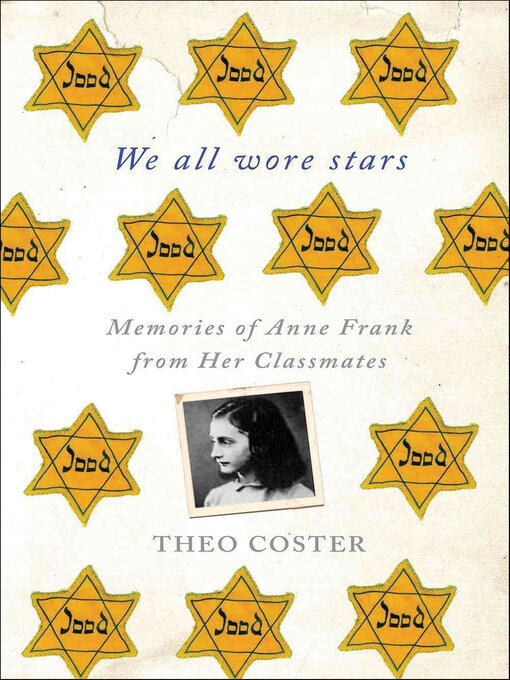In 1941, Theo Coster was a student at the Amsterdam Jewish Lyceum, one in a class of 28 Jewish children that the Nazis had segregated from the rest of the Dutch population. Among Theo's fellow students was a young Anne Frank, whose diary would later become one of the most important documents of the Holocaust. In this remarkable group portrait, Coster and five of his fellow classmates gather their personal stories and memories of Anne. The accounts collected here do not just help us to rediscover Anne Frank. They also stand on their own as remarkable stories of ingenuity and survival during the Holocaust—from Albert Gomes de Mesquita, who hid in ten different towns across Europe—to Hannah Goslar, who experienced the horrors of Bergen-Belsen but also made a miraculous reconnection with Anne days before her death.
-
Creators
-
Publisher
-
Release date
September 4, 2024 -
Formats
-
Kindle Book
-
OverDrive Read
- ISBN: 9780230340596
- File size: 1511 KB
-
EPUB ebook
- ISBN: 9780230340596
- File size: 2069 KB
-
-
Languages
- English
-
Reviews
-
Kirkus
July 15, 2011
A handful of classmates relegated to Amsterdam's Jewish Lyceum during World War II offer poignant, haunting memories of "Annelies."
During the Nazi occupation of the Netherlands, all Jewish children were forced to attend special schools—in the case of the author and Anne Frank, their families chose the Jewish Lyceum. Of the nearly 500 boys and girls at the school, only half survived the war; while in the Netherlands overall, the author cites 80 percent of the Jewish population were killed, twice the percentage of Jews in Belgium and France, thus undermining the myth about Dutch benevolence toward the Jews. The author, then 13, was known as Maurice and was cited by Frank in her diary as "one of [her] many admirers, but he's a rather annoying kid." He remembers how his schoolmates began to stop showing up for class—for example, by the spring of 1942, labor roundups for children as young as 16 were instituted and many families had gone into hiding, such as the Franks and the author's own dispersed family. However, many others operated under a "ghastly delusion" that in Nazi labor camps they would at least avoid hunger and illness. (Coster was taken to a farm in Vaassen and passed off as a visiting nephew.) In a joint book and film project, Coster managed to track down several surviving classmates for reminiscing, revealing stories as freshly searing as when they first occurred. Several of the survivors who had also ended up in Bergen-Belsen, like Anne, actually spoke to her there, and were impressed by her conviction to survive the war. All speak of Anne's vivacity and spirit, although they reveal some resentment of her singular fame. Details reveal the enormous pressure on the children in hiding to be quiet and not make trouble, and the absolute lack of professional help after the war in easing the emotional trauma.
The moving lore around the life of Anne Frank remains inexhaustible and eternal.
(COPYRIGHT (2011) KIRKUS REVIEWS/NIELSEN BUSINESS MEDIA, INC. ALL RIGHTS RESERVED.)
-
Kirkus
July 15, 2011
A handful of classmates relegated to Amsterdam's Jewish Lyceum during World War II offer poignant, haunting memories of "Annelies."
During the Nazi occupation of the Netherlands, all Jewish children were forced to attend special schools--in the case of the author and Anne Frank, their families chose the Jewish Lyceum. Of the nearly 500 boys and girls at the school, only half survived the war; while in the Netherlands overall, the author cites 80 percent of the Jewish population were killed, twice the percentage of Jews in Belgium and France, thus undermining the myth about Dutch benevolence toward the Jews. The author, then 13, was known as Maurice and was cited by Frank in her diary as "one of [her] many admirers, but he's a rather annoying kid." He remembers how his schoolmates began to stop showing up for class--for example, by the spring of 1942, labor roundups for children as young as 16 were instituted and many families had gone into hiding, such as the Franks and the author's own dispersed family. However, many others operated under a "ghastly delusion" that in Nazi labor camps they would at least avoid hunger and illness. (Coster was taken to a farm in Vaassen and passed off as a visiting nephew.) In a joint book and film project, Coster managed to track down several surviving classmates for reminiscing, revealing stories as freshly searing as when they first occurred. Several of the survivors who had also ended up in Bergen-Belsen, like Anne, actually spoke to her there, and were impressed by her conviction to survive the war. All speak of Anne's vivacity and spirit, although they reveal some resentment of her singular fame. Details reveal the enormous pressure on the children in hiding to be quiet and not make trouble, and the absolute lack of professional help after the war in easing the emotional trauma.
The moving lore around the life of Anne Frank remains inexhaustible and eternal.
(COPYRIGHT (2011) KIRKUS REVIEWS/NIELSEN BUSINESS MEDIA, INC. ALL RIGHTS RESERVED.)
-
Formats
- Kindle Book
- OverDrive Read
- EPUB ebook
Languages
- English
Loading
Why is availability limited?
×Availability can change throughout the month based on the library's budget. You can still place a hold on the title, and your hold will be automatically filled as soon as the title is available again.
The Kindle Book format for this title is not supported on:
×Read-along ebook
×The OverDrive Read format of this ebook has professional narration that plays while you read in your browser. Learn more here.

